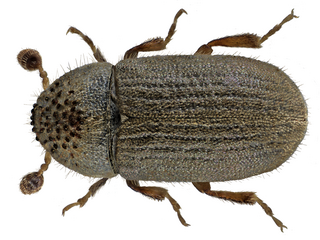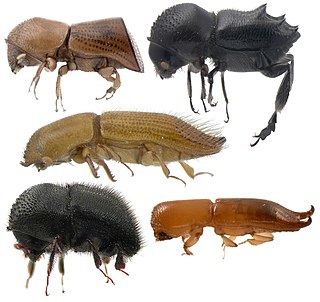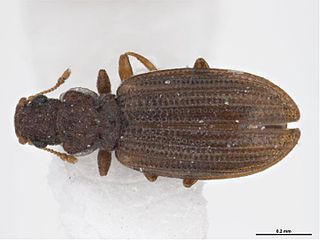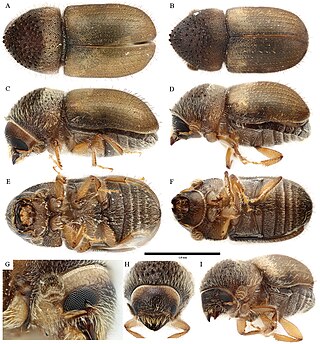Ambrosia beetles are beetles of the weevil subfamilies Scolytinae and Platypodinae, which live in nutritional symbiosis with ambrosia fungi. The beetles excavate tunnels in dead or stressed trees into which they introduce fungal gardens, their sole source of nutrition. After landing on a suitable tree, an ambrosia beetle excavates a tunnel in which it releases its fungal symbiont. The fungus penetrates the plant's xylem tissue, extracts nutrients from it, and concentrates the nutrients on and near the surface of the beetle gallery. Ambrosia fungi are typically poor wood degraders, and instead utilize less demanding nutrients. Symbiotic fungi produce and detoxify ethanol, which is an attractant for ambrosia beetles and likely prevents growth of antagonistic pathogens and selects for other beneficial symbionts. The majority of ambrosia beetles colonize xylem of recently dead trees, but some colonize stressed trees that are still alive, and a few species attack healthy trees. Species differ in their preference for different parts of trees, different stages of deterioration, and in the shape of their tunnels ("galleries"). However, the majority of ambrosia beetles are not specialized to any taxonomic group of hosts, unlike most phytophagous organisms including the closely related bark beetles. One species of ambrosia beetle, Austroplatypus incompertus exhibits eusociality, one of the few organisms outside of Hymenoptera and Isoptera to do so.

Cryphalus is a large genus of tiny bark beetles, subfamily Scolytinae, tribe Cryphalini in the family Curculionidae. The genus is widely distributed. The species feed and breed under the inner bark of trees. They infest mainly recently dead, dying or stressed trees. Some species are regarded as invasive pests, harmful to agriculture or forestry.

Larinus is a genus of true weevils, comprising about 180 species, mostly in the Palaearctic region with some species introduced to North America. Turkey appears to have a significant diversity of the group, with more than 50 species recorded in the eastern part of the country.

Xyleborini are a tribe of ambrosia beetles, highly specialized weevils of the subfamily Scolytinae. Much of the ambrosia beetle fauna in Eurasia and the Americas consists of Xyleborini species. Some Xyleborini are notorious invasive species.

Cartodere is a genus of beetles in the family Latridiidae, containing the following species:

Euwallacea fornicatus, also known as tea shot-hole borer, or polyphagous shot-hole borer (PSHB) is a species complex consisting of multiple cryptic species of ambrosia beetles known as an invasive species in California, Israel, South Africa, and Australia. The species has also been unintentionally introduced into exotic greenhouses in several European countries.
Cryphalogenes euphorbiae, is a species of weevil found in Sri Lanka.
Cryphalogenes exiguus, is a species of weevil found in Sri Lanka.
Euwallacea piceus, is a species of weevil native to Oriental Asia but introduced to African and other Westerns Pacific parts of the world. It is a serious pest in tropical and subtropical parts of the Americas.
Genyocerus albipennis, is a species of weevil endemic to Sri Lanka.

Hypoborus ficus, the fig bark beetle, is a species of weevil found in many European, Mediterranean and Asian countries.
Sueus niisimai is a species of weevil found in India, Sri Lanka, China, Japan, Taiwan, Korea, Malaysia and Indonesia. It is also found in Australia and Fiji, presumably introduced.
Debus emarginatus, is a species of weevil widely distributed throughout the Old World tropics.
Arixyleborus malayensis, is a species of weevil found in India, Sri Lanka, China, Japan, Malaysia, Vietnam and Indonesia. This is the only species of Arixyleborus found in Japan and China.

Cryphalus dilutus, the spurred bark beetle, is a tropical and subtropical bark beetle which attacks fig and mango trees causing dieback. It belongs to the family Curculionidae, subfamily Scolytinae.

Cryphalus mangiferae, the mango bark beetle, is a tiny tropical bark beetle which attacks mango trees. The species belongs to the family Curculionidae, subfamily Scolytinae. It is often cited as a vector of plant pathogenic fungi infecting mango trees and in some countries like Pakistan it is regarded as a serious threat to mango cultivation.

Cryphalus piceae, the small fir bark beetle, is a tiny bark beetle, about 1.7 mm long that is found in central and southern Europe. It infests mainly fir (Abies) and spruce trees (Picea) and occasionally can cause damage to branches and young trees, including tree death.

Cryphalus saltuarius - Cryphalus asperatus is a small bark beetle, around 1.8 mm long, that infests mainly spruce trees (Picea), less often other conifers. It has been recorded mainly from northern Europe and is occasionally regarded as a secondary pest. However, it attacks primarily weakened and freshly dead branches of its host trees.

Cryphalus abietis is a small bark beetle, around 1.6 mm long, that is widely distributed in Europe. It infests mainly spruce trees (Picea), but also other conifers. Like closely related species, e.g. Cryphalus saltuarius, C. abietis attacks primarily weakened and freshly dead branches of its host trees, and usually does not kill trees.

Euwallacea is a genus of typical bark beetles in the family Curculionidae. They are commonly known as Ambrosia beetles, as all species are symbiotic with Ambrosia fungi. Originally from Asia or Wallacea, they are now found worldwide. Many species are pests, causing damage to, or the death of, tree species valued for their fruit or timber.











